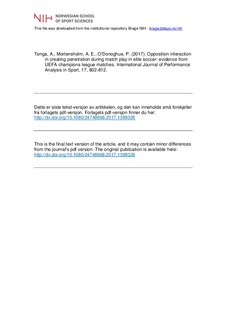| dc.contributor.author | Tenga, Albin | |
| dc.contributor.author | Mortensholm, Anders Eidem | |
| dc.contributor.author | O'Donoghue, Peter | |
| dc.date.accessioned | 2019-06-28T12:38:47Z | |
| dc.date.available | 2019-06-28T12:38:47Z | |
| dc.date.created | 2017-11-21T08:26:35Z | |
| dc.date.issued | 2017 | |
| dc.identifier.citation | International Journal of Performance Analysis in Sport. 2017, 17, 802-812. | nb_NO |
| dc.identifier.issn | 1474-8185 | |
| dc.identifier.uri | http://hdl.handle.net/11250/2602831 | |
| dc.description | I Brage finner du siste tekst-versjon av artikkelen, og den kan inneholde ubetydelige forskjeller fra forlagets pdf-versjon. Forlagets pdf-versjon finner du på tandfonline.com / In Brage you'll find the final text version of the article, and it may contain insignificant differences from the journal's pdf version. The definitive version is available at tandfonline.com | nb_NO |
| dc.description.abstract | The aim of this study is to compare how penetrations were created between the Finalists and Non-finalists by assessing opposition interaction in elite soccer. Sample included data from 12 matches played from the round of 16 to the final of the UEFA Champions League season 2010/2011. Differences in creating dangerous penetrations were found only after controlling for the effects of opponent’s defensive balance. Three way repeated measures ANOVA revealed that the interaction of team status and opponent’s defensive balance had a meaningful effect on the percentage of penetrative ball actions into dangerous spaces (F2,20 = 2.9, p = 0.076, partial η2 = 0.227). Finalists performed a higher percentage of dangerous penetrative ball actions per match than Non-finalists when playing against an imbalanced defence (89.2 ± 14.0 vs. 77.6 ± 13.6), while Non-finalists performed a higher percentage when playing against balanced (25.8 ± 10.7 vs. 16.1 ± 12.5) and beginning imbalanced (32.8 ± 10.9 vs. 29.1 ± 9.2) defences. Results suggest that effective exploitation of spaces within and behind the last line of opponent’s defence is an important determinant of successful offensive performance in soccer. The assessment of opposition interaction is of critical importance when analysing elite soccer performance. | nb_NO |
| dc.language.iso | eng | nb_NO |
| dc.subject | validity | nb_NO |
| dc.subject | match performance analysis | nb_NO |
| dc.subject | playing tactics | nb_NO |
| dc.subject | playing effectiveness | nb_NO |
| dc.subject | space utilisation | nb_NO |
| dc.subject | defensive balance | nb_NO |
| dc.subject | uefa champions league | nb_NO |
| dc.title | Opposition interaction in creating penetration during match play in elite soccer: evidence from UEFA champions league matches | nb_NO |
| dc.title.alternative | Opposition interaction in creating penetration during match play in elite soccer: evidence from UEFA champions league matches | nb_NO |
| dc.type | Journal article | nb_NO |
| dc.type | Peer reviewed | nb_NO |
| dc.description.version | acceptedVersion | nb_NO |
| dc.source.pagenumber | 802-812 | nb_NO |
| dc.source.volume | 17 | nb_NO |
| dc.source.journal | International Journal of Performance Analysis in Sport | nb_NO |
| dc.source.issue | 5 | nb_NO |
| dc.identifier.doi | 10.1080/24748668.2017.1399326 | |
| dc.identifier.cristin | 1516372 | |
| dc.description.localcode | Seksjon for coaching og psykologi / Department of Coaching and Psychology | nb_NO |
| cristin.unitcode | 150,32,0,0 | |
| cristin.unitname | Seksjon for coaching og psykologi | |
| cristin.ispublished | true | |
| cristin.fulltext | postprint | |
| cristin.qualitycode | 1 | |
